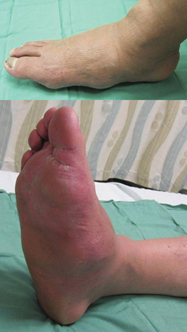Changes to Medicaid divide states, doctors
States get the final say in whether to expand their Medicaid programs and how to accomplish that. The resulting disparities have prompted physicians to get involved to secure access for their patients and funding for themselves, their practices and their hospitals.
One of the goals of the Affordable Care Act (ACA) was to make insurance coverage more equal across the country, but in fact it is about to become more varied than ever for adults near or below the poverty line.
Internists, patients and policymakers are facing several ACA-related changes to the Medicaid program, including the Supreme Court ruling that states could choose whether to expand Medicaid coverage.

“The toughest thing about Medicaid expansion, post-Supreme Court decision, is that what was supposed to be uniform across the country is now being decided on a state-by-state basis,” said Sara Wilensky, PhD, JD, a professor in the School of Public Health and Health Services at George Washington University in Washington, D.C.
In addition to expansion, states are dealing with a federal requirement to increase primary care physician payments up to Medicare levels, differences in benefits between current and future beneficiaries, and questions about who will be in the expanded Medicaid patient population. Many internists and their practices will be affected by the ultimate resolution of these state-by-state dilemmas.
Some doctors, though, aren't waiting on the sidelines and have already gotten involved to secure access for their patients and funding for themselves, their practices and their hospitals.
To expand or not
The biggest Medicaid issue has been expansion. Over the past year, state legislatures have debated and voted on whether to expand their programs in accordance with the ACA. Expansion, which would add childless adults with incomes up to 133% of the federal poverty level, is entirely funded by the federal government through 2015, after which states would take on an increasing fraction of the costs.
“Just about half the states are actively planning to expand Medicaid as of January 2014. The rest of the states are still in the process of making a decision or have decided at least for now that they're not expanding Medicaid,” said Genevieve Kenney, PhD, co-director and a senior fellow in the Health Policy Center of the Urban Institute in Washington, D.C.
Georgia fell firmly into that third category, to the disappointment of Jacqueline W. Fincher, MD, MACP, a private practice internist and Governor for ACP's Georgia chapter. “There was almost no discussion at the state legislature about it this year. It wasn't going anywhere, and it wasn't lack of advocacy on the part of many organizations, including ours,” she said.
In many states, ACP members banded together with other primary care specialties to push for expansion. The College supports Medicaid expansion and issued a position paper in 2011 calling for uniform national Medicaid coverage to serve low-income children, adults and families regardless of categorical eligibility, as well as a number of other changes to the program.
In many states, expansion supporters encountered opposition not only from legislators but also from their patients and colleagues, largely based on politics.
“There's certainly not unanimity among physicians about support for Medicaid expansion, particularly in the South. There's a lot of opposition to Obamacare in general and that bleeds over to Medicaid expansion,” said S. Clark Fincher, MD, FACP, a general internist and Governor for ACP's Arkansas chapter.
In addition to stressing the benefits to patients gaining health care access, advocates of expansion made a financial case. “The citizens of Georgia are going to pay the same taxes that everyone else does, and other states are going to get billions and we're going to get zip,” said Dr. Jacqueline Fincher.
In fact, because the ACA reduces Medicare Disproportionate Share Hospital payments, on the assumption that previously uncompensated care would be covered by expanded Medicaid, the financial consequences of not expanding are worse than zero.
“They postponed the effect of that to the end of next year, but over the long term, it's going to be brutal to our hospitals,” said Robert B. Brahan, MD, FACP, a general internist in Hattiesburg, Miss., and former Governor for his state ACP chapter. “Probably every hospital in Mississippi is now gearing up to reduce their overhead one way or another. My hospital is trying to figure out how to get rid of 50 jobs.”
The opposition to expansion was not purely political in Mississippi, Dr. Brahan noted. “A lot of the objection from doctors was that we have a program here in our Medicaid, which was a managed care program involving two insurance companies, and it has not worked well,” he said.
The expansion debates were shaped by local factors, confirmed Dr. Clark Fincher, who led one of the few Southern successes for expansion advocates. The Republican-majority Arkansas legislature approved expansion by one vote, with a key privatizing modification.
“We got a waiver from [the Department of Health and Human Services] in Washington to use Medicaid expansion dollars to fund premiums for private insurance within the state health care exchange,” he said. “It was more palatable to the legislators.”
Intensive lobbying also contributed to the success, he added. “We started early, by supporting candidates for the legislature who we thought were for or could be convinced to be for Medicaid expansion,” he said.
The Arkansas physicians also rallied the business community to their cause. “If it's just doctors and hospitals, it looks self-serving, because we're going to benefit from all these new people having insurance. You need to get other groups involved who don't necessarily have that same interest,” Dr. Clark Fincher said.
Perhaps his lobbying advice will be useful in states that revisit the issue of expansion during the next couple of years. “From a budget perspective, it just seems like too good a deal for states to walk away from,” said Dr. Kenney. “You're going to see pressure from providers, consumers and from state budget officials.”
Dr. Jacqueline Fincher is optimistic that this pressure will be sufficient in Georgia to pass expansion on the next try, once the Republican governor is re-elected to his final term next year. “I hope he will help the legislature see the writing on the wall, and the billions of dollars we're giving up that could tremendously benefit our state and our citizens,” she said.
But all is not perfect even in the states that voted to expand Medicaid. California passed expansion, but state budget problems have raised concerns about the stability of the entire MediCal program.
“Most practicing physicians are very pessimistic about the financial status of Medicaid in California,” said Susan Sprau, MD, MACP, a pulmonologist in Santa Monica, Calif., and past president of the California chapter's ACP Services. “There's a lot of uncertainty.”
The state's financial crisis has already led to a 10% cut in Medicaid physician reimbursement rates, enacted in 2011 but not yet instituted due to legal challenges. That cut came on top of already low pay. “California currently has the lowest reimbursement rate in the nation for Medicaid payments to physicians,” said Dr. Sprau.
Reimbursement rises
The difference in Medicaid rates between states was supposed to lessen under the ACA. As of Jan. 1, 2013, states were instructed to use federal funds to reimburse primary care services for Medicaid patients at the same rates paid by Medicare.
“There are some states where Medicaid [reimbursement] is 40% less than Medicare, so it could be a really big increase,” said Dr. Kenney.
Georgia is one of the states with a significant gap: Medicaid pays about two-thirds of what Medicare does, according to Dr. Jacqueline Fincher. The problem is that Georgia internists are still waiting for the increase. “Georgia is saying now they're not going to be up and running until November. We've already been doing the work since January,” she said. “It's kind of frustrating.”
Most states have promised that the payments will be retroactive, either all the way back to January or to the date that a physician attested to qualify (which requires either board certification in a specialty considered primary care, such as internal medicine, or a majority of past Medicaid billings being primary care services). But many of the states, like Georgia, have had delays in beginning higher payments.
“It's a combination of it being a complex policy change to implement, particularly in the face of the heavy reliance on managed care in Medicaid, and the fact that guidance on this provision was issued close to the time that policy change was due to be enacted,” Dr. Kenney said.
Again, Dr. Clark Fincher had the most positive report. “Our clinic has already begun to receive those increased payments. It makes a big difference for us financially and in our ability to see patients with Medicaid,” he said.
Part of the motivation for the increase is to attract more access for Medicaid patients, but experts are uncertain how likely the program is to achieve that goal. Measuring the impact of the increase could be difficult, given implementation delays, the temporary nature of the increase, and the multitude of changes taking place at the same time, according to Julia Paradise, MSPH, an associate director of the Kaiser Commission on Medicaid and the Uninsured.
“Fee levels are the most important factor that comes up when physicians are asked about their participation in Medicaid, but there are other factors, too,” she said. “The magnitude of this Medicaid fee increase doesn't really have any precedent—it's much greater than any fee increase research has looked at before.”
The increased rates may lose some appeal for physicians when new patients acquire private insurance next year through the ACA's health insurance exchanges. “Compared with nothing and Medicaid, you pick Medicaid, but compared with private insurance and Medicaid, you pick private insurance, if you were just looking from a purely financial basis,” said Dr. Clark Fincher.
Physicians also wonder what will happen when the federal requirement and funding for the parity increase expire at the end of 2014. “I've heard different points of view on this,” said Dr. Kenney. “From the states' perspective, if the new norm is this higher rate, they say it could be very hard for them to back that down.”
However, it could also be hard for states to find the money. “They can't do deficit spending,” said Dr. Kenney. “The fact that the Medicaid program is so dependent on states' financial health does introduce complexities. You can't generalize about what will happen in 2015, because my guess is it will differ dramatically across the country.”
Meanwhile, physicians will have committed themselves to the expansion in their Medicaid patient panel.
“You get enmeshed with that patient, and then you're in an obligatory relationship when the pay goes back down,” said Dr. Jacqueline Fincher. For a private practice physician, this can be a significant financial burden, she said. “All the social determinants of care tremendously affect this population. You need a full-time social worker in your practice.”
New patients
The continuing financial challenge is one reason that experts suspect that private practice physicians will not be picking up the bulk of the expanding Medicaid population. Community health centers have been consistently receiving more funding over the past decade, noted Dr. Kenney. “They seem like they're in a better position to serve Medicaid patients than they were 10 years ago,” she said.
Hospital acquisitions of physician practices may also have an impact. “The hospitals' stake in Medicaid could affect whether the physicians who are aligned with that hospital open their practices to Medicaid patients,” said Dr. Kenney.
Dr. Jacqueline Fincher agreed. “For those providers who are salaried by organizations that see a lot of Medicaid, [the reimbursement] doesn't matter to them,” she said. “If you're going to do a Medicaid practice, the only way to do it is on volume and with mid-level providers.”
But, she noted, her assumptions about the cost and time constraints of care are based on the current participants in Medicaid. Patients under expansion “are going to be a different demographic, and may be healthier and maybe not as socially and educationally challenged,” she said.
Dr. Kenney has research to support that supposition. She and colleagues used the National Health and Nutrition Examination Survey to analyze the population eligible for expanded Medicaid. Results published in the June 26 Journal of the American Medical Association showed a number of differences from the current patients. The new group is more white, more male, more educated, less obese, and most important, has fewer disabilities and chronic medical conditions.
“If participation rates among this newly eligible population reach high rates, the costs of serving this population will be lower on average than the costs of serving the current Medicaid population,” said Dr. Kenney.
There is a catch, however. Perhaps not surprisingly, given that the expansion patients have had less access to care, any chronic conditions they do have are more likely to be undiagnosed or uncontrolled.
“Not only does this suggest that they'll benefit from coverage, but it also suggests that in the early years following their enrollment, they may have a higher need for care,” said Dr. Kenney. “Individuals themselves may not be aware of all the health issues they're facing, so screening and diagnosis is really critical as they're coming back into care.”
Other researchers have recently highlighted another important difference between expansion patients and existing Medicaid recipients. In an article in the July Health Affairs, Dr. Wilensky and a co-author compared the preventive services covered for current and future beneficiaries. The ACA mandates that states' expanded Medicaid programs cover all preventive services rated A or B by the U.S. Preventive Services Task Force but does not affect preventive services coverage for existing recipients.
“They all have to be covered for the expansion population, but for the existing population, it's a separate question whether a state chooses to coordinate coverage so everybody gets the same or not,” Dr. Wilensky said.
It's a recipe for confusion about exactly what is covered, she found. “It's hard to find these things out,” particularly for the beneficiaries themselves, she said. “Some of these handbooks, they would say things like, ‘You're entitled to preventive services, such as ...’ and list one or two, but not give you an actual list.”
Clinicians may have an easier time understanding, but they could still face uncertainty if states retain vague standards like “age-appropriate screening” for the non-expansion beneficiaries. The upside of the ambiguity is that it gives clinicians some room to interpret appropriateness using the guideline of their choice. “Are providers aware of the flexibility they have to choose the coverage standard, whether it's the American Cancer Society, the Task Force, or the American Heart Association?” said Dr. Wilensky. “I bet a lot of them don't know.”
Adding the new Medicaid expansion population with more covered services will likely exacerbate the confusion. Some states may expand their existing programs to match or at least to cover some additional services, but others will not. “Physicians will have to follow developments in their state,” Dr. Wilensky said.
Her advice applies to Medicaid as a whole over the next few years, as some states expand near the ACA's goal of universal coverage, and others do not. “There will be large gaps in coverage in states that don't move forward, because individuals with incomes below the poverty line are not eligible to participate in subsidies in the exchanges,” said Robin Rudowitz, an associate director for the Kaiser Commission on Medicaid and the Uninsured. “It creates a lot of inequities within states and across states.”
Dr. Brahan, for one, is not looking forward to practicing on the disadvantaged side.
“We're in that belt of southern states between Texas and South Carolina that are not going to benefit from Obamacare,” he said. “I'm afraid that because of the loss of [Medicare Disproportionate Share Hospital] money, our hospitals are going to suffer greatly and our economy will suffer because of that.”




